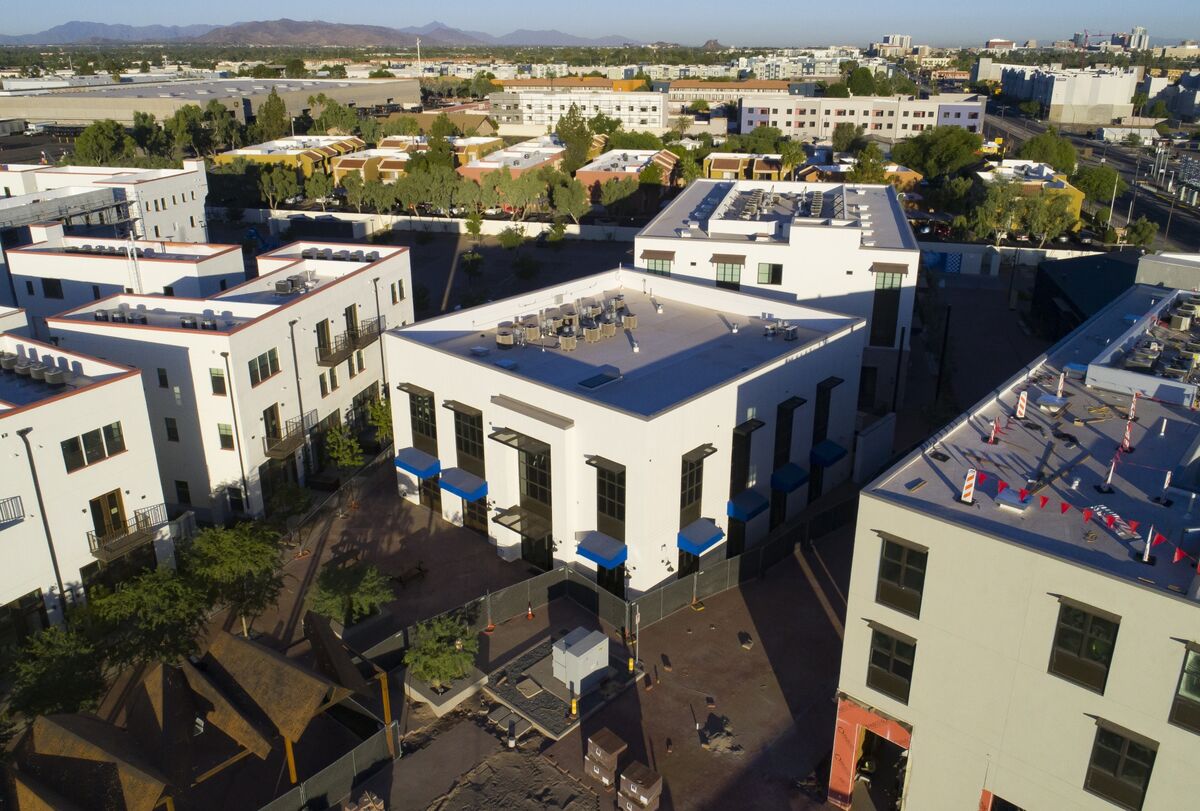
Can This Car-Free Neighborhood Clone Itself?
The developers of Culdesac Tempe, a $200 million mixed-use community without cars or parking, are looking to export their design model to other cities.

Culdesac Tempe’s first residents have moved in, and the company is eyeing expansion in other cities.
Photographer: Rebecca Noble/Bloomberg
Citylab
Housing
Can This Car-Free Neighborhood Clone Itself?
The developers of Culdesac Tempe, a $200 million mixed-use community without cars or parking, are looking to export their design model to other cities.By Patrick Sisson
December 15, 2023 at 10:19 AM EST
In downtown Mesa, Arizona, the 27-acre patch of land known as Site 17 has sat empty for decades, a redevelopment mystery that has yet to be unraveled. The local Mesa Tribune compared it to Nevada’s Area 51, noting that “developers have hovered, coming close to landing — then, as mysteriously as UFOs, vanished.” Past plans have included turning the city-owned dirt lot, once home to 63 single-family homes, into a health-care facility and resort/water park.
But in October, the city took a big step towards solving this real estate riddle, by selecting a proposal to build a housing project from the startup Culdesac, famous for its car-free neighborhood taking shape in nearby Tempe. Over the coming weeks, the city and Culdesac will negotiate a memorandum of understanding, which is expected to be presented to the council for a final vote early in 2024. Mesa officials are banking on the Site 17 project to help catalyze a downtown revival.

This long-vacant lot in Mesa, Arizona, could soon be transformed into a car-light neighborhood.Source: City of Mesa[/font]
Culdesac became an urbanist darling in the US for its project in Tempe, a built-from-scratch zero-driving development that is transforming a vacant lot near a light rail stop into the kind of dense and walkable neighborhood that advocates say could be a model for other places trying to shun American-style car-centricity. The $200 million project’s high profile, stark minimalist look, and green bona fides definitely helped Culdesac’s bid, says Jeff McVay, Mesa’s manager of downtown transformation.
“They’ve always given us the impression that while there’s a profit motive involved in this, it’s a socially conscious profit motive to help better the community that they live in,” said McVay. “That’s the kind of partnership that makes me excited.”
But Culdesac’s Mesa proposal isn’t a carbon-copy of the Tempe project. For one thing, it looks like it’s going to have some cars: Currently, the project is slated to have 800 parking spaces with its 1,000 residential units, because the site lacks the kind of transit access that its predecessor has.
The attention that the car-free neighborhood has drawn since opening up the first block of apartments underscores the potential of this style of development, where residents get around predominantly via transit or other mobility services. There are several other residential projects underway from other developers in various US cities that follow parts of this car-free or -light approach. But looking at where Culdesac seeks to go next, and the status of these projects, raises questions about just how replicable the company’s approach is, due to the very local nature of planning and zoning decisions.
Culdesac declined an opportunity to respond to questions about its future plans, or any questions related to this article. “We’re not commenting on any expansion plans for the time being,” Ryan Johnson, the company’s chief executive officer, said in an email. Mesa is just one of a handful of future sites Culdesac, a Silicon Valley startup that has raised $47 million in venture capital, is currently working on.
Read more: Car-Free Living Takes Off in Car-Centric Cities
In Atlanta, for example, Culdesac has plans to develop a 20-acre site called Murphy Crossing, adjacent to the BeltLine, the city’s rails-to-trails project. Culdesac has been named a developer finalist, though the project to redevelop the warehouse district technically remains an open procurement, with public updates expected in the coming months.

Just what these future projects will look like could depend less on the vision of the company’s designers and planners and more on what municipalities will allow, according to Ryan Wozniak, a Phoenix-area transportation planner who has closely watched the progress of Culdesac Tempe, and credits that city’s leaders with prioritizing walkability and transit access as goals for that project. It’s not surprising that’s where Culdesac’s concept found fertile ground.
“They are the municipality that’s gung-ho for infill development along the light rail, and can see the benefits of a car-free community,” said Wozniak. “It’s a beautiful thing, when you actually marry up visionary community development with a real commitment to sustainable transportation options. But it’s a little chicken-and-egg-ish.”

